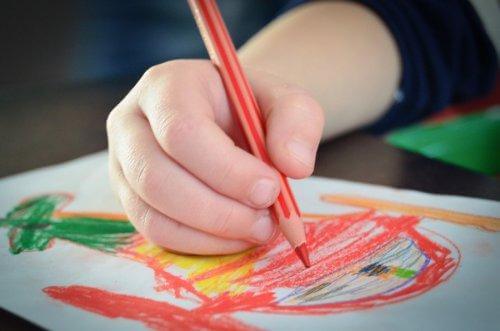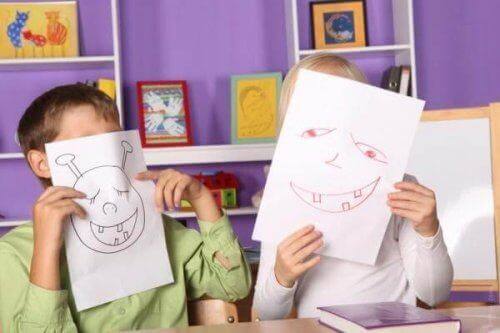7 Ways to Stimulate Children's Creativity Through Drawing


Written and verified by the psychologist María Alejandra Castro Arbeláez
Drawing is an excellent tool to foster creativity and imagination. Read on to discover seven ways that drawing can help stimulate children’s creativity.
The importance of fostering creativity at an early age is well known. It’s also well known that creative children are more resourceful when facing difficulties.
Drawing stimulates creativity
According to Professor Ángeles Gervilla, creativity is the ability to create something new, whether it be a product, a technique, or a way of dealing with reality.
Nowadays, creativity is very important in all areas of life: work, education, family and personal life. If we help stimulate children’s creativity, we’ll promote their adaptive capacity to face the many challenges that’ll come their way.
Many schools encourage children to draw since early childhood. This is because drawing helps stimulate creativity in the first years of a child’s life. Drawing is a means by which children explore and develop both their personality and their surroundings.
For Viktor Lowenfeld, drawing is a form of expression that children can use since an early age. He argues that children can create new ideas through drawing, which is why it helps them develop a flexible mindset.
“Creativity isn’t only a personal capacity, but also an attitude towards life.”
–Issam Madi–

7 ways to stimulate children’s creativity through drawing
- Use blank paper and avoid drawing templates. This way, children can express their originality and feel free. Drawing templates are usually only for coloring and don’t allow children to add something new to the drawing.
- Challenge them to draw things that scare them or things they dislike in fun ways.
- Let them be inspired by nature. Normally, children love to draw elements of nature such as flowers and animals. Boost their creative side by challenging them to draw an animal in the least ordinary way possible, stepping outside the box.
- Make up stories and ask them to draw the characters. Make up a story without overly describing its characters. As they listen to the story, children will have already created their own mental images of the characters. When you finish the story, ask them to draw the characters.
- Take advantage of special holidays or events. Ask children to draw about local holidays or special events to discover what they think of them.
- Comics. Ask them to tell a story through drawings. Comics are excellent tools that foster creativity and boost their narrative skills.
- Draw and play as a family. Family time stimulates children’s creativity. In addition, games help improve the family dynamic and ultimately strengthen family ties. Try Pictionary as a family, which is a game in which one team has to draw a random word that the other team has to guess.
For these reasons, drawing isn’t just a hobby, but also an educational activity for children. It helps children develop both mentally and personally. It also helps them learn to express their emotions.

For children, drawing is a way to express both their concerns and frustrations and their desires and joys.
Drawing is an excellent tool to foster creativity and imagination. Read on to discover seven ways that drawing can help stimulate children’s creativity.
The importance of fostering creativity at an early age is well known. It’s also well known that creative children are more resourceful when facing difficulties.
Drawing stimulates creativity
According to Professor Ángeles Gervilla, creativity is the ability to create something new, whether it be a product, a technique, or a way of dealing with reality.
Nowadays, creativity is very important in all areas of life: work, education, family and personal life. If we help stimulate children’s creativity, we’ll promote their adaptive capacity to face the many challenges that’ll come their way.
Many schools encourage children to draw since early childhood. This is because drawing helps stimulate creativity in the first years of a child’s life. Drawing is a means by which children explore and develop both their personality and their surroundings.
For Viktor Lowenfeld, drawing is a form of expression that children can use since an early age. He argues that children can create new ideas through drawing, which is why it helps them develop a flexible mindset.
“Creativity isn’t only a personal capacity, but also an attitude towards life.”
–Issam Madi–

7 ways to stimulate children’s creativity through drawing
- Use blank paper and avoid drawing templates. This way, children can express their originality and feel free. Drawing templates are usually only for coloring and don’t allow children to add something new to the drawing.
- Challenge them to draw things that scare them or things they dislike in fun ways.
- Let them be inspired by nature. Normally, children love to draw elements of nature such as flowers and animals. Boost their creative side by challenging them to draw an animal in the least ordinary way possible, stepping outside the box.
- Make up stories and ask them to draw the characters. Make up a story without overly describing its characters. As they listen to the story, children will have already created their own mental images of the characters. When you finish the story, ask them to draw the characters.
- Take advantage of special holidays or events. Ask children to draw about local holidays or special events to discover what they think of them.
- Comics. Ask them to tell a story through drawings. Comics are excellent tools that foster creativity and boost their narrative skills.
- Draw and play as a family. Family time stimulates children’s creativity. In addition, games help improve the family dynamic and ultimately strengthen family ties. Try Pictionary as a family, which is a game in which one team has to draw a random word that the other team has to guess.
For these reasons, drawing isn’t just a hobby, but also an educational activity for children. It helps children develop both mentally and personally. It also helps them learn to express their emotions.

For children, drawing is a way to express both their concerns and frustrations and their desires and joys.
All cited sources were thoroughly reviewed by our team to ensure their quality, reliability, currency, and validity. The bibliography of this article was considered reliable and of academic or scientific accuracy.
- Lowenfeld, V. (1987). Desarrollo de la capacidad creadora. Ed. Kapelusz. Argentina: Buenos aires.
- Madi, I. (2012). La creatividad y el Niño. Palibrio. Estados Unidos.
- Wallon, P., Cambier, A. y Engelhart, D. (1992). El dibujo del niño. Siglo XXI editores. España: Madrid.
This text is provided for informational purposes only and does not replace consultation with a professional. If in doubt, consult your specialist.








